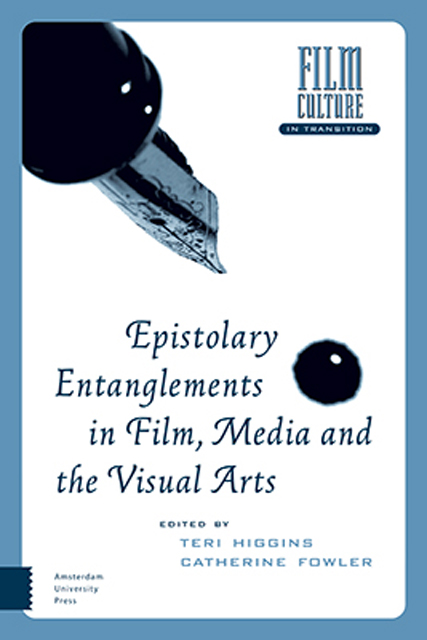Book contents
- Frontmatter
- Table of Contents
- Acknowledgements
- Doing (Audio-Visual) Things with Words – From Epistolary Intent to Epistolary Entanglements: An Introduction
- 1 Performance and Power : The Letter as an Expression of Masculinity in Game of Thrones
- 2 ‘My dearest little girl, I just got your letter and I hope that you will continue to write to me often’: Epistolary Listening in News from Home (Chantal Akerman, 1976)
- 3 Dead Letters: Epistolary Hauntology and the Speed of Light in Personal Shopper (Olivier Assayas, 2016)
- 4 Attention to Detail: Epistolary Forms in New Melodrama
- 5 The Spiritual Intimacies of The Red Hand Files: How Long Will I Be Alone?
- 6 Video Authenticity and Epistolary Self-Expression in Letter to America (Kira Muratova, 1999)
- 7 Epistolary Affect and Romance Scams: Letter from an Unknown Woman
- 8 Delivering Posthumous Messages : Katherine Mansfield and Letters in the Literary Biopic Leave All Fair (John Reid, 1985)
- 9 The Interactive Letter : Co-Authorship and Interactive Media in Emily Short’s First Draft of the Revolution
- 10 Epistolary Distance and Reciprocity in José Luis Guerín and Jonas Mekas’s Filmed Correspondences
- 11 Instagram and the Diary : The Case of Amalia Ulman’s Excellences & Perfections (2014)
- 12 Civil War Epistolary and the Hollywood War Film
- 13 Epistolarity and Decolonial Aesthetics in Carola Grahn’s Look Who’s Talking (2016)
- 14 Epistolary Relays in Fatih Akin’s Auf der anderen Seite (On the Other Side/On the Edge of Heaven) (2007)
- Index
3 - Dead Letters: Epistolary Hauntology and the Speed of Light in Personal Shopper (Olivier Assayas, 2016)
Published online by Cambridge University Press: 20 June 2023
- Frontmatter
- Table of Contents
- Acknowledgements
- Doing (Audio-Visual) Things with Words – From Epistolary Intent to Epistolary Entanglements: An Introduction
- 1 Performance and Power : The Letter as an Expression of Masculinity in Game of Thrones
- 2 ‘My dearest little girl, I just got your letter and I hope that you will continue to write to me often’: Epistolary Listening in News from Home (Chantal Akerman, 1976)
- 3 Dead Letters: Epistolary Hauntology and the Speed of Light in Personal Shopper (Olivier Assayas, 2016)
- 4 Attention to Detail: Epistolary Forms in New Melodrama
- 5 The Spiritual Intimacies of The Red Hand Files: How Long Will I Be Alone?
- 6 Video Authenticity and Epistolary Self-Expression in Letter to America (Kira Muratova, 1999)
- 7 Epistolary Affect and Romance Scams: Letter from an Unknown Woman
- 8 Delivering Posthumous Messages : Katherine Mansfield and Letters in the Literary Biopic Leave All Fair (John Reid, 1985)
- 9 The Interactive Letter : Co-Authorship and Interactive Media in Emily Short’s First Draft of the Revolution
- 10 Epistolary Distance and Reciprocity in José Luis Guerín and Jonas Mekas’s Filmed Correspondences
- 11 Instagram and the Diary : The Case of Amalia Ulman’s Excellences & Perfections (2014)
- 12 Civil War Epistolary and the Hollywood War Film
- 13 Epistolarity and Decolonial Aesthetics in Carola Grahn’s Look Who’s Talking (2016)
- 14 Epistolary Relays in Fatih Akin’s Auf der anderen Seite (On the Other Side/On the Edge of Heaven) (2007)
- Index
Summary
Abstract
This chapter explores the ways that ‘letterness’ and its accompanying features affect communications in the digital age. Forms of communication that rely on a system of discarnate forms such as the text message, email, and video conferencing assume an embodied corporeal subject ‘out there’. Through an analysis of modes of communication in the 2016 film Personal Shopper (Olivier Assayas, 2016), this chapter takes a close look at the delivery device, questioning how the delivery mechanism of the epistle rather than the medium literally embodies the object of our anxieties in an age where the delivery system and the subject are now virtually indistinguishable.
Keywords: epistolary hauntology; text messages; delay; Olivier Assayas; Personal Shopper
It struck him that people are not really dead until they are felt to be dead. As long as there is some misunderstanding about them, they possess a sort of immortality. E.M. Forster, A Passage to India
Standing alone in her small Parisian apartment, Maureen continues to watch a video. She had begun watching it on her iPhone while on the train, the wires of her earbuds snaking up from under her sweater into her ears. Now the video continues on the laptop propped open on her bed, sound emerging from the laptop speaker. The transition of the film from one device to another as Maureen moves not only from one location to the other, but also viewing part of it as she is in the process of moving from one place to the next, is so quotidian a part of contemporary life that these transitions go unnoted. The sound, previously transmitted to her ears only because of the earbuds, is now audible throughout her apartment, but still heard by her alone. In both cases, sound is transmitted to the film's viewers in exactly the same way, through the film that we are watching, wherever we are and however we are experiencing it.
Maureen is wearing a dress that is not her own, a dress that she is supposed to return to the Chanel showroom for her employer, a socialite named Kyra, who also does not own the dress, and whose main occupation is to be photographed in clothes borrowed from luxury brands in a mutually sustaining form of advertising.
- Type
- Chapter
- Information
- Publisher: Amsterdam University PressPrint publication year: 2023



